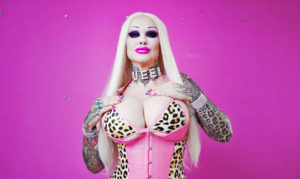In All Bar Ones up and down the country, a silence descended. In the aisles of B&M, in between pyramids of discounted Brazilian Bum Bum Cream, women softly wept. French bulldogs howled in unison from Astroturfed pens on their new-build estates. For Wednesday was the day that love died.
Molly-Mae Hague and Tommy Fury, both 25, first locked eyes in a hot tub in 2019. She, a canny Love Island bombshell. He, a puppyish, smooth-brained hunk. It was a match made in heaven. The “boxer” — he is the half-brother of Tyson Fury, and so appears in celebrity bouts — and the influencer (who became genuinely successful as creative director of fast-fashion sausage factory Pretty Little Thing, reportedly on £400,000 a month) became models of Fiat500 love. They had a baby, a girl called Bambi. They bought a £4 million house in Cheshire (where else?). Tommy proposed to Molly-Mae by taking her on a fake “brand trip”, before surprising her with a £1 million engagement ring.
But, after this romantic apogee, the pretty little pits beckoned. After a few months of ringless paparazzi shots, hints at “solo parenting” and suspect Dubai club videos, Molly-Mae called it a day. She released a statement, sombrely overlaid on a black background, involving the now-immortal sentence: “After five years of being together, I never imagined our story would end, especially not this way.” Especially not this way. Tommy’s good name was in the mud. What hussy, what 10-a-penny Instagram model, had muscled onto Molly-Mae’s turf?
The briefings began. An ally of Double M told The Sun: “It seems he would play away when he knew people wouldn’t recognise him.” Reports of a “Danish girl in Macedonia” emerged, causing homeware manufacturers up and down the country to hastily pulp their autumn hygge ranges. Tabloids called up experts to pick over the bones of the break-up, with one calling up a family lawyer to speculate about who had rights to the house (Tommy, from the sounds of things, would be out on his arse). Over the coming days, millions of us crept through both parties’ Instagrams, looking for clues, signs of resentment. Immediately after the split, Google searches for the couple exceeded those for Taylor Swift.
Such is the model of celebrity break-ups: despite seeming sordidly modern, this is in fact a well-rehearsed routine, one which has its roots in a century or more of prurient mass-media tittle-tattle. The first relationship to implode in this way, and to keep journalists in French 75s for weeks on end, was the golden couple of Twenties Hollywood: Douglas Fairbanks and Mary Pickford. As the silent film stars struggled with the transition to the talkies, rumours of infidelity abounded. In the end, the pressure of their status as Hollywood’s most blessed couple was too much.
Their unravelling perfected the formula for celebrity splits. The tortuous fate of Richard Burton and Elizabeth Taylor’s ultimately doomed romance was foretold, and perhaps encouraged, by their roles as the drink-fuelled brawlers George and Martha in 1966’s Who’s Afraid of Virginia Woolf? — a sure sign that celebrity romances had taken on some metatheatrical cynicism, had jumped the shark into cunning media awareness. The blurring of the line between public persona and private emotion was now irreversible, and the media had successfully transformed relationships into a monetisable intrigue, public property.
Then, the early Nineties saw the consummate messy break-up: Charles and Diana. Every celebrity since, noble or otherwise, has followed in the wake left by this most toxic and tragic of couples. The press briefings, the “revenge” dressing; Diana’s genius blend of public vulnerability and media savviness has become the model for all wronged women, one which Molly-Mae is sure to find herself replicating, consciously or not.
That Charles and Di were a royal couple is significant. Once, royal marriages modelled Christian fidelity to the public, even, and perhaps especially, when mistresses were an open secret. Successful queens, such as Catherine of Braganza or Caroline of Ansbach, maintained a dignified stoicism in the face of bombastic infidelity. Like them, Diana, the teenaged virgin, was selected for her meekness — and once, this would have been kept intact by the ancient stoicism of queenly custom. But she had been vastly underestimated: the girl who, by rights, should have been a saintly doormat had, in fact, the revolutionary cunning of Anne Boleyn (who, it is no coincidence, was a distant ancestor of both Diana and Camilla Parker-Bowles). The tabloid darling did away with careful court politics: now, the press, correctly cajoled, could use the tormented lover archetype pioneered by Pickford and Taylor to create a true celebrity of a royal wife — and even better, a martyr.
Every celebrity break-up since this one, from Brangelina to Katie Price and Peter Andre, has followed the same routine. She is crazy and jealous, says the man; he broke his promises, says the woman. Her friends “rally around her” — as when Molly-Mae “broke cover” with a Mercedes full of ladies-in-waiting for an emergency trip to McDonald’s. He is pictured in nightclubs of varying quality, surrounded by lesser, hungrier versions of his ex. Now, celebrities are known to hire “break-up coaches” to guide them in “healing their heart” (Kourtney Kardashian’s lifestyle brand has an in-house consultant for exactly this purpose). No doubt much of this role, when dealing with high-profile clients, will involve media choreography: the first “girls’ night out”, the first new man, the first “swipe” at the ex.
It is a pattern which, for the most part, we as voyeurs have created through our insatiable appetite for public suffering. These tropes are comforting for us, because they reinforce the stereotypical gender roles of relationships. For female watchers in particular, there is great catharsis in seeing infidelity inflicted on famous women: it reassures us that we are united in disgruntlement. Rather than feeling jealous of the rich and glamorous, we feel deliciously close to their suffering. For celebrities, this schadenfreude is transactional: if your job is to be famous, as it is for Molly-Mae, a public break-up — particularly a “shock” one — is, perversely, the best thing that could possibly happen to you. A rebrand is sure to follow, along with endless corporate partnerships.
The influencer industry is built purely around personalities, real-life soap operas. Because of the disappearing boundaries of reality and performance, Molly-Mae has, I am sorry to say, given herself no option but to publicly re-enact her private traumas. The slippage is so absolute that all genuine emotion becomes suspect: though it would be unfair to suggest the pair’s entire five-year relationship was driven by PR (after all, celebrities too have real relationships producing real children), private adoration must always be filtered through the lens of each party’s online avatar. Public fascination adulterates love: it must be hard to be dazzled by someone everyone already knows everything about; it must feel like lying in bed with a hologram. And because of the ubiquity of the press — every fan with a phone is now a celebrity reporter — this publicity is inescapable.
In this sense, Molly-Mae’s heartbreak is not the shock that it is said to be. It is the fulfilment of a promise, an unspoken contract between watchers and performers, consumers and cash cows. We are vengeful gods demanding sacrifice from indentured celebrities — blood is our reward for upholding our side of the bargain: using the code “TOMMYMAE4EVA” for 10% off our first purchase. Though I am sure Double M still believes in the fiction of her own privacy, and would be horrified to recognise herself as a willing participant in her public heartbreak, this is exactly what she is.
This is more than a personal cataclysm: it is also a content drop. Disaster generates far more emotional and literal currency than the other side of influencer content, advertorial carousels of gifted products. Molly-Mae will have noticed the thousands of new followers she has gained since this latest, fatal instalment in the Molly-Tommy saga: she cannot possibly resent this. This break-up is an inevitable epilogue in a show scripted by prodding ITV producers five years ago; its only surprise is that it has been allowed to sweetly ripen before plummeting to the soil, ready for waiting worms.
Molly-Mae is a hardy sort of woman, and will ultimately be fine. One of the things people liked about her on Love Island was that she had her head screwed on. But we must be a little more critical of the circus around such stories: for they are really just gladiatorial spectacles of heartbreak commissioned by ourselves. They are sources of twisted amusement, of pain enjoyed. These relationships are designed to fail: however much the participants believe their love to be purely theirs, it was in public ownership from the very start — and even the fans who strive to “be kind” love nothing more than to see an influencer cry.
Disclaimer
Some of the posts we share are controversial and we do not necessarily agree with them in the whole extend. Sometimes we agree with the content or part of it but we do not agree with the narration or language. Nevertheless we find them somehow interesting, valuable and/or informative or we share them, because we strongly believe in freedom of speech, free press and journalism. We strongly encourage you to have a critical approach to all the content, do your own research and analysis to build your own opinion.
We would be glad to have your feedback.
Source: UnHerd Read the original article here: https://unherd.com/




